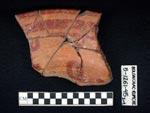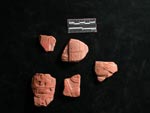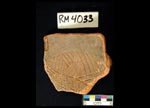
| FAMSI © 2004: Arturo René Muñoz |
||||||||||||||||||||||||||||||||||||||||||||||||||||||||||||||||||||||||||||||||||||||
|
The Ceramic Sequence of Piedras Negras, Guatemala: Type and Varieties The Kumche Ceramic Phase (A.D. 850–A.D. 900?) Kumche is the final ceramic complex at Piedras Negras and marks the complete abandonment of the site. The beginning of the Kumche ceramic phase is marked by the introduction of Tres Naciones Fine Gray and Altar Fine Orange types into the site around A.D. 850. The absence of succeeding occupation makes dating the end of this phase exceptionally difficult. Given the quantities and distribution of Kumche ceramics, the virtual absence of construction, and the very low quantities of Post Classic ceramics recovered, it seems likely that only 50 to 75 years passed before Piedras Negras was completely abandoned. The occasional presence of Post Classic ceramics indicate that after about A.D. 900–925 Piedras Negras was visited only occasionally by pilgrims or others passing through the region. Most Kumche polychromes are poorly preserved, though Bolonchac Orange Polychrome seems to be the most common type. No polychromes equivalent to the Terminal Classic types known from elsewhere in the Petén, such as Lombriz Orange Polychrome (Adams 71:39), are recognized at Piedras Negras. Altar and Tres Naciones fine pastes are, by far, the most diagnostic elements of Kumche assemblages. Their presence, however, in a number of terminal middens (e.g. op 46j, Golden 2002), allowed the identification of a number of formal and decorative modes that allowed the identification of Kumche deposits independent of the presence or absence of fine paste ceramics. Diagnostic forms include basins with triangular rims and near vertical walls, hollow, zoomorphic supports and/or notched basal ridges on shallow plates, hollow zoomorphic censer elements, and everted and grooved rims on unslipped utility forms, slipped bowls with out-curved walls are common diagnostic. In addition, shallow plates with out-curved walls and cylindrical or spherical supports are also diagnostic of the Kumche phase. The frequent use of smudging to darken the interior of serving vessels, an increased frequency of abstract geometric motifs on the interior of serving dishes, and the use of parallel rows of incised lines on the exteriors bowls all serve as Kumche diagnostic. Finally, it is important to note that a distinctive change in paste color and texture also serve to mark the Kumche phase. The paste of a large percentage of Kumche phase vessels is significantly redder and tempered and has a much finer carbonate temper than present in vessels manufactured during prior phases. The reasons for this shift are unclear, but may be related to an attempt to replicate the fine paste pottery entering the site at this time.
|
||||||||||||||||||||||||||||||||||||||||||||||||||||||||||||||||||||||||||||||||||||||
|
Text links to all pages at this site are available at the FAMSI INDEX |
||||||||||||||||||||||||||||||||||||||||||||||||||||||||||||||||||||||||||||||||||||||


